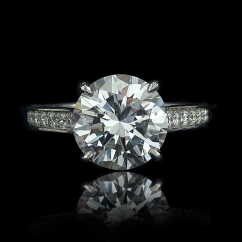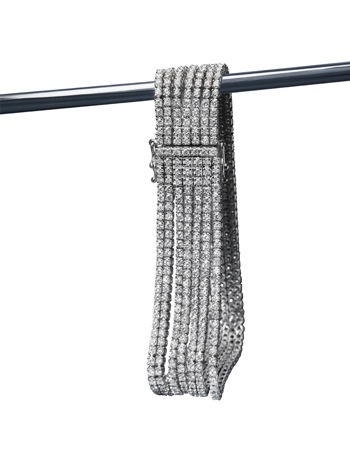Articles and News
ARE WE FLOATING IN A DIAMOND PRICE BUBBLE? | April 20, 2011 (0 comments)

Merrick, NY—Ask anyone in the trade about diamond prices and they’re guaranteed to shudder or launch into discourse about how hard it is to cope with an increase just now as the market’s recovering.
But closer examination shows that while prices are indeed heading up—and are likely to remain elevated—it doesn’t necessarily portend another bubble, nor are all the increases unreasonable. Still, diamond dealers are somewhat divided in their opinion about where the market is headed and the best strategy to follow.
Moshe Klein of New York-based Julius Klein says smart retailers have seen the writing on the wall and have been stocking up, while those who don’t really follow the diamond market closely often are shocked when they go to buy more stones. He also believes higher prices are here to stay, at least for the immediate future.
“A few months ago, a one carat AGS Triple Zero was 20-25 back of Rap, now it’s only seven, eight back. That’s the reality.” In New York, he says, people have been lining up to buy goods—even melee has almost doubled. Still, he’s concerned that the increases are too much, too fast.
“When oil goes through the roof, people say it’s 80% because of speculation. The diamond industry isn’t as bad, but I feel there is some speculation,” he says. A diamond solitaire ring from his firm is pictured above left.
He may not be far off the mark. While De Beers has cautioned clients against speculation, it also has warned that rough supplies are tight, which prices already have borne out. That can lead to, well, speculation.
Rough stuff. Polished prices have yet to catch up with the increased prices of rough. From the low points of 2009, rough prices have increased as much as 10 times more than polished prices. Part of this, says Klein, is because mines that curtailed production during the recession need time to ramp back up, and no new mines are coming online.
But Russell Shor, senior industry analyst at GIA, says the mines may not be in such a hurry to ramp up production. It’s a classic mining strategy to hold back production somewhat when prices are on the rise, serving the dual purpose of both extending the life of the mine and fetching higher prices for its output in the future.
Shor puts polished price increases into perspective. They’re up, but much of the increase is about recovery to pre-recession levels, not a rocket to the stratosphere.
“Bread and butter goods—the quarter carat to 1.5 carat sweet spot—are back to pre-2007 levels.” Prices went down 20% to 30% in 2008-2009, and now they’ve recovered the lost ground and gone somewhat above—but not appreciably so, he says. “Prices for these goods were relatively stable for 10 years. They didn’t appreciate that much.”
Prices for goods in the two to five carat range—a staple for luxury jewelers—also have recovered and surpassed pre-recession levels. While they’ve risen more than bread-and-butter prices, again, Shor says it’s still not stratospheric. But they are sustainable increases, so retailers will need to adjust to the new price, he says.
The little big guys. Ironically, some of the biggest increases are for the smallest stones. As Klein observed, melee prices have almost doubled, while Jeffrey Link, president of A. Link and Co., New York, says when it comes to top quality smalls, those increases are more like 300% or 400%. Parcels of the best goods under seven points, and especially under two points, can fetch $1,300 or $1,400, and people are even pre-paying for production in this category, used by luxury manufacturers such as Richemont, LVMH, or Tiffany.
“I grew up with small diamonds, and I’ve always felt there was a lack of respect for well-made smalls. It’s easier to learn how to cut a well-made one-carat stone than a well-made one-point stone. It’s a completely different art,” says Link.

A multi-strand diamond bracelet from A. Link & Co.
He cites several factors for the increase: the low dollar and the rising cost of labor.
During the recession, overseas factories let skilled workers go, and many of those workers now are unavailable for rehire as they’ve been absorbed by other industries like apparel and shoes. It’s just now that they’re being replaced, but it still will take time before production really cranks up, Link says. At the same time, labor prices in low-wage countries like China aren’t as low as they used to be.
Conversely, an area where prices have very recently begun to level off is for the mega-stones typically sold at auction, says Shor. While those prices haven’t come down, they do seem to have peaked and hit a plateau.
Renewed faith. “Price increases are significantly high, but it shows the market is stable and people believe in diamonds,” says Amir Goldfiner of Rahaminov Diamonds in Los Angeles. His firm has had a very strong first quarter with some very successful trunk shows.
“We think prices are up because demand is up. All over the world, people believe in diamonds; believe they’re a safe haven. It’s a good place, to be in diamonds.”
“Diamonds are getting a newfound respect they haven’t had in ages, especially smalls, and that’s good news,” says Link.
Retail demand unquestionably is up. Goldfiner says his retail customers are buying and selling, while Diamond Trading Company International managing director Varda Shine in a recent speech predicted a 6% or 7% increase in sales by value for 2011. That being said, however, any jumps in total sales by value must take into account price increases for both gold and diamonds.
While currency fluctuations may be helping diamond prices, as Goldfiner and Link observe, Shor cites other factors with influence.
One is tighter credit. Banks have gotten much stricter about excessive memo deals, now looking for maximum terms of 60 days with perhaps a 30-day extension, versus the 120 days or more that used to be common. Another significant factor is a dramatic increase in stones from secondary sources such as pawnshops or estate jewelry. Says Shor bluntly, “This channel is subsidizing the high cost of rough.”
Link concurs. “It’s happening across the board—luxury stores, non-luxury stores, everyone’s doing it. We talk to retailers and ask how they’ve survived the last two years and they’ve melted down and reused pieces and diamonds.”
Larger pieces can be melted down and the diamonds re-set, or the piece may just be cleaned up and re-sold as is if the style is appropriate. But the small stuff makes big money.
Sell me your stones. Using simple (not actual) numbers to illustrate, a customer sells a ring to a jeweler or a pawnshop. They get $300 for the gold but only minimal—say $5—for any melee diamonds in it. The jeweler or pawnshop owner pries out the diamonds and tosses them into a box, then melts down the gold. A pawnshop broker (someone who buys and sells all those boxes of miscellaneous melee) makes the rounds and offers $15 for the box. He in turn sells the box to an Indian firm for $100. The box goes back to India; its contents are sorted and mixed into other melee parcels, which are then sold back here for $500 (or more).
It’s a lot cheaper than buying and cutting rough, says Shor. The selling price of these stones can be as much as 70%-80% under Rap. So if the average discount off Rap is 30%, that’s quite a spread.
How high are prices likely to go? And how much are diamantaires willing to go out on a limb to get the goods?
Amir Goldfiner says any discussion of diamond prices also needs to include a discussion about diamond marketing. “We don’t promote diamonds right,” he says. “A Birkin bag [Hermes] is $30,000 but it wears out in a few years. A diamond you wear forever. The diamond you can upgrade. The bag you can’t. I had a customer trade a diamond from years ago, and she got more money than she paid for it.”
Goldfiner has a point. With apparel prices expected to rise about 17.4% this year, and gasoline and food prices climbing as well, consumers really demand to see the value of anything they buy.

18k rose gold and diamond jewelry from Rahaminov, Los Angeles.
The wallet will tell. The sharp increase in melee may have significant impact at the counter. The enormously popular micropave styles in fashion right now depend on melee, which already cost more last year than it did the year before.
“When it’s used as an accent, it’s not as hard to accept the price as for a full micropave piece,” says Link. “But at the end of the day, the consumer will decide if the style is worth the price. Only time will tell. And if the retailer buys it but the customer doesn’t, I’m looking at it back.”
Moshe Klein and Russell Shor both fear a tipping point where the industry prices itself out of the market.
“I don’t know if the affluent American consumer is ready or not [for price increases],” says Klein. “It keeps me up at night. I’m not sure but that we could price out of the market. A five-carat stone, it’s almost cheaper to buy a house.”
Shor says nobody knows where the tipping point is—they just know when it happens. And by then, it might be too late.
“Someday a consumer who’s been saving up for an engagement ring might look at the price and say, ‘What am I getting for $5,000? Not much!’ and just decide not to buy it,” he says. Or they might opt for color, especially as Kate Middleton’s sapphire ring has sparked renewed interest in color.
Klein says, “We have to be sure we act responsibly. People have short memories. They tend to forget [2008-2009]. Long term, the price has to be justifiable. Is a 10%-15% increase justified? Yes. But can you justify a price that’s 60% up, or doubled? No.”
Goldfiner, meanwhile, remains bullish on diamonds. “Any nice diamond I see, I’m buying. I’m not afraid. You can’t sell from an empty wagon.”







